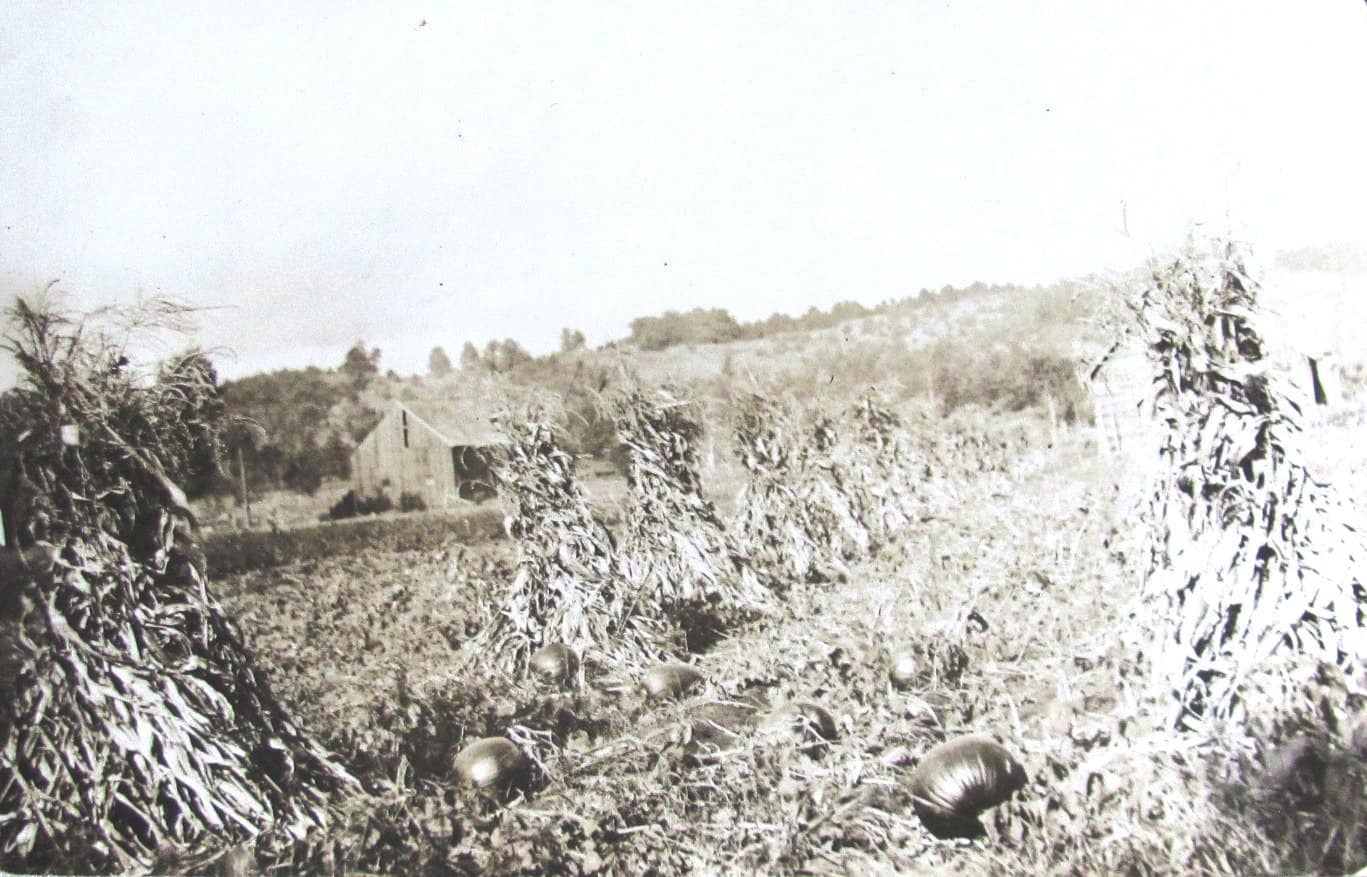
I had three sisters, but they are not the subjects of this article. Native Americans taught white settlers how to grow crops. Indians had developed corn, squash, and beans long before the arrival of the white man.
This method of growing crops together is known as The Three Sisters.
A practice developed by the Indians was planting corn, climbing beans, and squash together. Corn and beans were planted in hills or mounds together. As the corn and beans grew, the beans would climb the cornstalks like a trellis.
Corn, beans, squash, and pumpkins are companion plants; each is beneficial to the other. Beans growing up cornstalks reinforced the cornstalks, protecting them from wind damage.
In the photo with this article you’ll notice pumpkins growing between the stooks of corn. The large leaves of pumpkins growing amongst the rows of corn and beans kept weeds down and shaded the soil from the hot sun.
This photo shows two rows of corn stooks. In the old days after cornstalks were cut, they were tied up in upright bundles, called stooks, as you see here. This is how cornstalks were dried. The cornstalks needed to dry before they were chopped up for silage.
In many cases, cornstalks were cut by hand with a corn cutter. A corn cutter has a curved blade, like a sickle, with a short wooden handle.
When the corn stooks were dry, they were brought to the barn by horse and wagon. Most every farm had a corn cutter. A corn cutter is a wood frame machine, operated manually. On the top is a very sharp, iron guillotine type cutter with a long handle.
The cornstalks were laid in a horizontal, triangular shaped wooden tray. Lift the guillotine handle and advance the cornstalks forward 2–4 inches. Push the guillotine handle down, and many cornstalks would be cut at once. This would be repeated many times. Eventually horse-drawn machines replaced these older methods.
Today, tractors pulling harvesters cut and chop cornstalks into silage. The silage is then blown through a chute into the silo. Silage is fed to cows during the winter. It’s a very efficient way of life.
Before the corn was cut, the beans would be harvested. In the old days, many area farms had a bean winnower. A bean winnower is a wooden machine with a crank. Inside the winnower are a couple screens and a blower.
First the beans needed to be thrashed. Beans were laid out on the barn floor. Using a bean flail, the beans are struck with the short end of the flail. If the beans were dry, the shells would break open on impact of the flail. The beans were swept up along with some chaff and run through the bean winnower.
The beans were loaded into a hopper at the top of the winnower, sifting down to the top screen. When the crank is turned, the screens sift back and forth. In the bottom of the winnower is a wooden blower, driven by a leather belt. The blades of the blower forced air up through the screens. This air blows the chaff off. The beans drop out a chute at the bottom and are collected in bucket or other container.
These old photos document a way of life now long gone. This circa 1910 photographer might have seen the coming changes in agriculture. Perhaps he felt it important to create a photographic record, before it was gone forever. I’m glad he did.
On another subject, I recently found a 1903 notebook. It is unlined paper, measuring 7 inches by 6 inches. I think it probably had a front and rear cover, now gone.
The title page, written in old ink, is “Epitaphs.” This individual recorded interesting epitaphs he encountered in area cemeteries. The first page: “Found in the church yard Old Town Rockingham.” Oct. 3, 1903…
…The Lowell Lake cemetery, Saxtons River, and Windham cemeteries are included. Here are two epitaphs that made me chuckle:
“Here lies the body of Solomon Peas
Under the sod and under the trees
Not the peas but only the pod
The peas shelled out and gone to God”
Another epitaph:
“Here lies the body of old Miss Charlott
Who died a virgin and not a harlot
She lived seventy years in her virginity
An unusual thing is this vicinity”
This week’s old saying: “Having a degree might qualify you for a position. Lacking a degree should not disqualify you.”